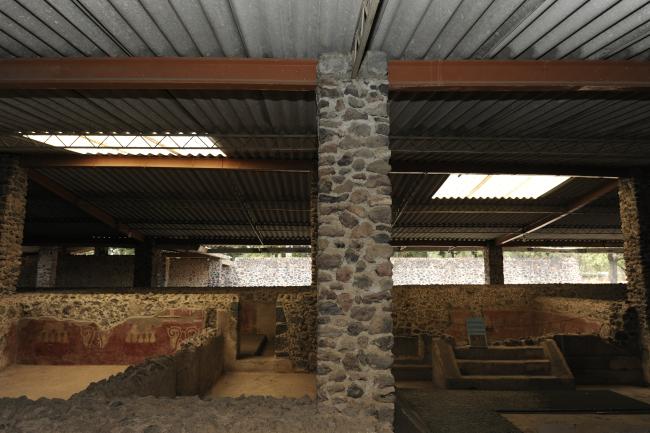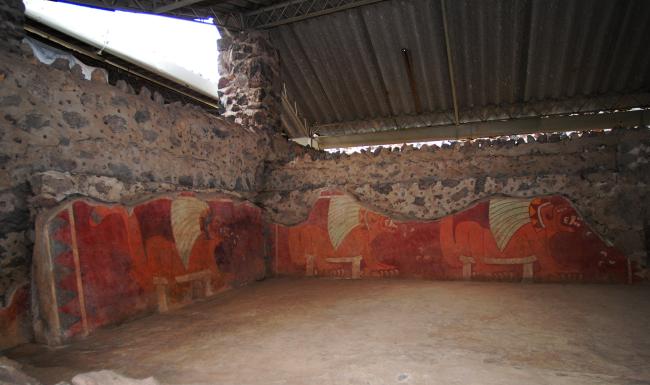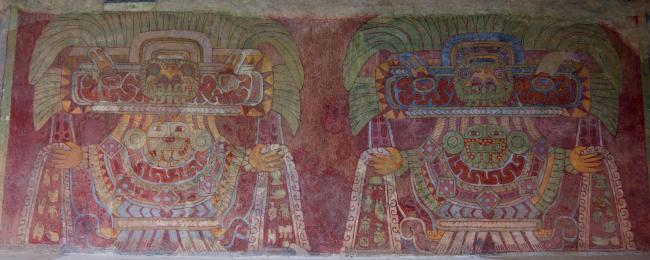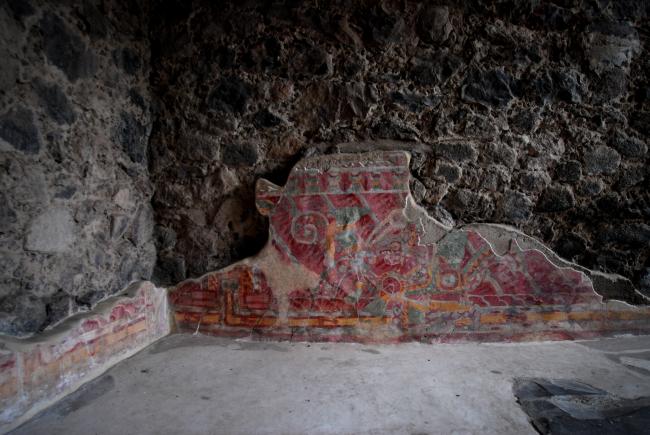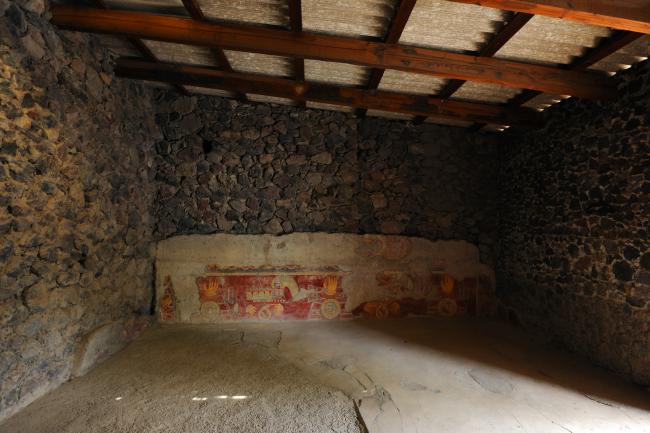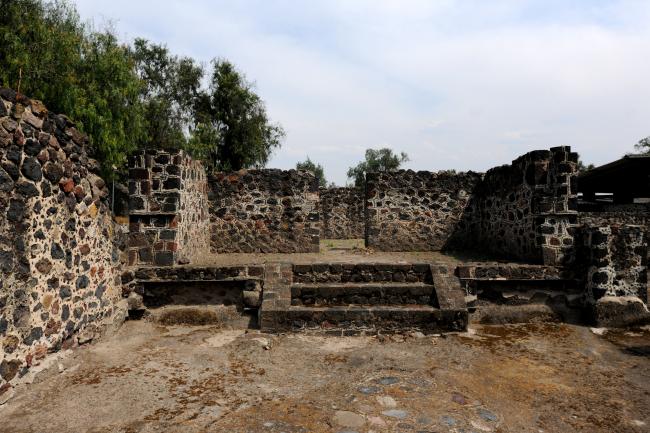
Tetitla
This complex is located in the western sector of the city, where you can observe a complex housing system and part of its development shown through several construction levels.
In some of its rooms are exposed extraordinary murals with diverse themes, among which stand out, for their composition, color and symbolism, the murals of Tlaloc, god of lightning, large eagles with wings spread, pumas with large plumes placed in profile in a kind of throne, priests with jaguar costumes associated with temples and streams of water.
In one of the main patios of this complex the stylistic evolution of the mural painting can be observed, since three sets of paintings corresponding to three different constructive levels are exposed.
Orange felines: This is a series of felines seen in profile that rest their belly on a stool, the claws of two of their paws reach the ground, and their tail curves upwards at the tip. The head is large and with vigorous features; the forehead is small, the muzzle very open and with thick lips reveals its teeth and large fangs. Its headdress is composed of a diadem of green and yellow triangles, and an elaborate plume of green feathers; there are two trilobed forms that seem to descend from the snout, one aligned to the teeth and the other in the direction of the legs. The slope is framed by a border, in which red and black triangles alternate above a narrow yellow band, above these triangles there are footprints that give the impression of roads.
Fuente, Beatriz de la (coord.), 1995, La pintura mural prehispánica en México Teotihuacán, volume I, Mexico, UNAM/IIE.
Hands with drops: Two hands are observed flanking huge fangs and taking drops coming down from scrolls.
Fuente, Beatriz de la (coord.), 1995, La pintura mural prehispánica en México Teotihuacán, volume I, Mexico, UNAM/IIE.
Jade goddess or green Tlaloc: The main image is seen from the front, and although her body or limbs are not visible, she seems to be seated on a stool with her arms crossed; her neck is covered by necklaces and her yellow hands extended, with fingers spread apart and thumbs up indicate that she is a female or bisexual deity of corn, earth and vegetation. The figures wear a green mask that gives them a human appearance, the mouth plate, below the wings of the nose, is a strip with three rings - horizontally arranged - in its center; the teeth are a central piece and two fangs that curve outward. The green earmuffs are formed by a disk and a concentric ring; the collars are six uninterrupted semicircular bands that surround, descend and widen below the mask; below the bands that embrace the quadrets and above the cape, the pectoral is seen in the center of the image with a diamond design that continues through angles, pointing in the opposite direction a horizontal bar with blue elements and, below it, blue and white diagonal bands descend.
The headdress occupies less than the total height and width of the image, the importance given to it in the pictorial space indicates its quality to detonate the identity of the image; it is made up of two sections: the lower one, composed of overlapping horizontal bands, which together give the appearance of a rectangle with rounded corners, and the upper one, tucked in on the sides, which is composed of other bands and feathers. In the center is placed an eagle's face, seen from the front, with round eyes bordered by a semicircular band, the flat nose shows the nostrils and the beak points towards the center; below it there is a transversal bar with appendages -similar to teeth and/or fangs- that are directed symmetrically up and down; on each side of the bird's face there are two spiral designs, from which a yellow and curved shape spirals upwards, ending in three blue drops.
The border is made up of two intertwined bands, like snake bodies, which are suspended at the corners with tied designs; one of the bands is dark red and has geometric designs of rectangles and quads inside; the other has a blue background with a design of feathered bivalve shells; the shells are red and the feathers are green.
Fuente, Beatriz de la (coord.), 1995, La pintura mural prehispánica en México Teotihuacán, volume I, Mexico, UNAM/IIE.
Jaguar man kneeling in front of temple: Two main images constitute the scene: a human figure disguised as a jaguar and a temple towards which he is heading; the latter is richly decorated with jaguar skin, tassels and chalchihuites; both form a symbolic scenic unit; other images -objects, ornaments, designs, border- reinforce the meaning of the primordials. The man disguised as a jaguar, with the body, face, ears and extremities of blue color, covered with designs of red interlaces that simulate a net, sinks the left knee on the water way that arrives to the temple; he raises the arm of the same side to hold a staff, and bends the right one to take a shield; the posture identifies him as human. On a platform of slope and board the temple rises whose walls are decorated with designs of flowers -yellow and red- of the skin of the feline; in the ends, which two pilasters, designs of concentric disks of green color are noticed. The temple is accessed through a blue square that produces a mirror of water to which three paths lead: two with “water eyes” and the one in the middle with footprints; the ceiling is formed from bottom to top, by double bands -red and blue-, above, is repeated seven times in horizontal row the element “tassel with feathers”, composed of circles and bundles of feathers downwards; above a board whose frame is constituted by concentric discs of green color, the lower and upper moldings, and by petalillo design -red and green- on the sides.
The two images man-jaguar and temple stand out, like cut paper figures, on the background composed of inclined bands: some are thin -blue green and white- and the others are wide segments with peaks in two shades of red; the design of diagonal bands is interrupted in the lower part by three extensive horizontal strips superimposed: they are the water and dirt roads that lead to the temple. The bottom one and the third one upwards are similar: on a blue background they carry alternating, and in opposite directions, “water eyes”; the second one shows alternating red and green human footprints; these three bands bend and end at the water mirror below the temple.
Fuente, Beatriz de la (coord.), 1995, La pintura mural prehispánica en México Teotihuacán, volume I, Mexico, UNAM/IIE.


